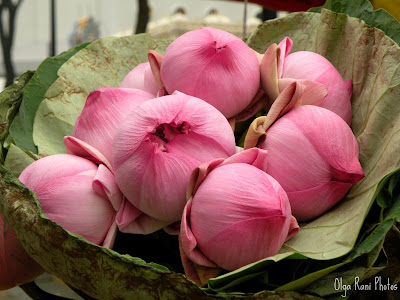Namaste!
Lotus is one of the most beautiful and amazing flowers in the world. First time I saw it "alive" while travelling in Thailand: the surfaces of the small ponds were completely covered with these beautiful flowers. Later I noticed that most devotees visiting Buddhist temples carry lotuses with them. For those people the lotus is the flower of Buddha. According to legend, Buddha was born with the ability to walk and lotus flowers bloomed wherever he stepped. The thing that has always amazed people in lotus is that it always looks clean and fresh in spite of growing in muddy and stagnant waters. The whole secret is in the special structure of the leaves and petals of the lotus - they have the ability to repel moisture and self-cleaning. Moisture on the surface of the lotus forms the drops and rolls, taking with them all the dirt. And every night the lotus flower closes and hides under the water, to reappear in the morning.
In ancient Egypt lotus was depicted on tombs and on the altars of sacrifice, where it symbolized resurrection from the dead, and the lotus hieroglyphs signified joy and pleasure. Pharaohs in the sign of their divine origin wore wreaths of lotus flowers on their heads and their sovereign scepter was also made in the form of a lotus.
As a decorative funerary motif symbolizing resurrection lotus appeared in ancient Greece and Italy. In Japan lotus is emblem of incorruptible morality.
In Hinduism lotus is a symbol of what is divine or immortal in humanity, and is almost a synonym of perfection.







No comments:
Post a Comment